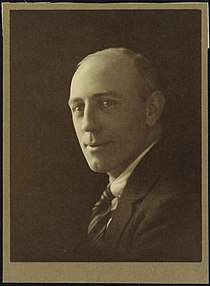Daryl Lindsay
Sir Ernest Daryl Lindsay | |
|---|---|
 Lindsay in c. 1930 | |
| Born | Ernest Daryl Lindsay 31 December 1889 |
| Died | 25 December 1976 (aged 86) Mornington, Victoria, Australia |
| Occupation | Artist |
| Spouse | Joan à Beckett Weigall (m. 1922) |
Sir Ernest Daryl Lindsay (31 December 1889 – 25 December 1976), known as Dan Lindsay, was an Australian artist.
Early life[edit]
He was the youngest son in a large family born to Anglo-Irish surgeon Robert Charles Alexander and Jane Elizabeth Lindsay (née Williams), of Creswick, Victoria, who had ten children. Daryl and his brothers Percy (the eldest), Lionel, and Norman, achieved distinction in the arts. Ruby, also an artist, became well known in artistic circles as the wife of the cartoonist/illustrator/journalist Will Dyson.
Prior to World War I, Daryl became a jackaroo near Collarenebri.
Military service[edit]
He served with the AIF in France.[1]
Following his active service in France, in England he made a very substantial contribution to the advancement of military reconstructive surgery with the extensive set of images he produced for Sir Harold Gillies, while serving as Lieutenant D./E. Lindsay, the official "medical artist" at the specialist military hospital at Sidcup, in Kent.[2][3][4]
Formal studies[edit]
He made many contacts in the art world and studied at the Slade School of Art in London.
He had moderate success with his paintings of white flowers - a difficult subject to capture successfully.
Career[edit]
Returning to Australia he became fascinated with the ballet during first tour (1936–1937) of "Colonel W. de Basil's Monte Carlo Russian Ballet" (i.e., the Ballets Russes) to Australia, sketching them during rehearsals, as in their performances.
He later published a book of his sketches, Back stage with the Covent Garden Russian ballet, and illustrated Arnold Haskell's memoirs, Dancing Round the World: Memoirs of an Attempted Escape from Ballet.
In 1940, he became a curator at the National Gallery of Victoria, rising to director from 1942 to 1956.
He also became a member of the Commonwealth Art Advisory Board in 1953. On 31 May 1956 he was knighted for "services to art".[5]
Personal life[edit]
In 1922, in England, he married Joan à Beckett Weigall, who, as Joan Lindsay, would later write Picnic at Hanging Rock. When the couple returned to live in Australia, they built a house called Mulberry Hill at Langwarrin South, on the Mornington Peninsula, and lived there until the Great Depression forced them to take more humble lodgings in Bacchus Marsh, renting out their home until the economic situation improved. Joan Lindsay left Mulberry Hill to the National Trust when she died in 1984.[6]
Death[edit]
He died on Christmas Day 1976, in Mornington, Victoria, six days before his 87th birthday. He was survived by his wife. They had no children.[7][8][9]
Publications[edit]
- Back Stage with the Covent Garden Russian Ballet (Sydney: s.n., 1938?)
- F. Philipp and J. Stewart, eds., In Honour of Daryl Lindsay: Essays and Studies (Melbourne: Oxford University Press, 1964)
- The Leafy Tree: My Family (Melbourne: F. W. Cheshire, 1965).
See also[edit]
Notes[edit]
- ^ Unlike all of his (otherwise) official records (e.g., birth records at Victorian Birth, Deaths, and Marriages; his entry at the Australian Dictionary of Biography, etc.) — which have him as "Ernest Daryl Lindsay" — all of his military records have him as "Daryl Ernest Lindsay".
- ^ Daryl Lindsay: Artist and Writer, National Museum of Australia.
- ^ (Watercolour, by Daryl Lindsay, of Private Thomas on admission, from the collection of the Royal Australasian College of Surgeons).
- ^ 'Camofleur', "Musketeers of Brush and Pencil with the A.I.F.: Art Under Fire: The Battlefield as Studio", The (Melbourne) Herald, (1 February 1919), p. 4.
- ^ It's an Honour: Knight Bachelor
- ^ Smith, Bernard (1986), "Lindsay, Sir Ernest Daryl (1889–1976)", Australian Dictionary of Biography.
- ^ Sir Daryl Lindsay dies at 86, The Canberra Times, (Monday, 27 December 1976), p.1.
- ^ Sir Daryl Lindsay, last of a family of artists, dies at 86, The Sydney Morning Herald, (Monday, 27 December 1976), p.3.
- ^ Aiton, Douglas, "Death of the last of the famous Lindsay family of artists: Sir Daryl: A Man who loved Life", The Age, (Tuesday, 28 December 1976), p.2.
References[edit]
- First World War Embarkation Roll: Driver Daryl Ernest Lindsay (10883), collection of the Australian War Museum.
- First World War Nominal Roll: Lieutenant Daryl Ernest Lindsay, collection of the Australian War Museum.
- First World War Service Record Lieutenant Daryl Ernest Lindsay, National Archives of Australia.
Further reading[edit]
- Joanna Mendelssohn, Lionel Lindsay : An artist and His Family, London : Chatto & Windus, 1988
External links[edit]
- 1890 births
- 1976 deaths
- Australian Knights Bachelor
- 20th-century Australian painters
- 20th-century Australian male artists
- People from Creswick, Victoria
- Artists from Victoria (state)
- Australian male painters
- Australian war artists
- Medical illustrators
- Australian military personnel of World War I
- Military personnel from Victoria (state)
- Australian people of English descent
- Australian people of Irish descent
- Lindsay family
